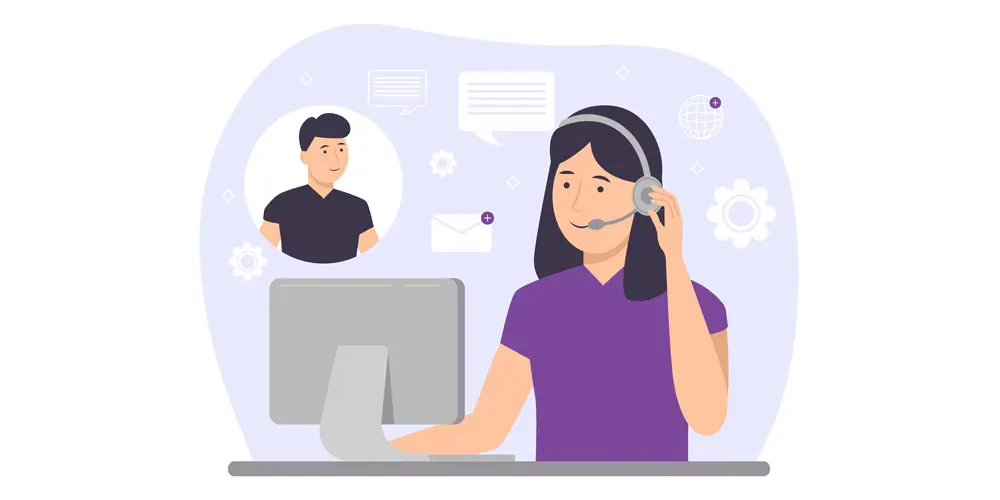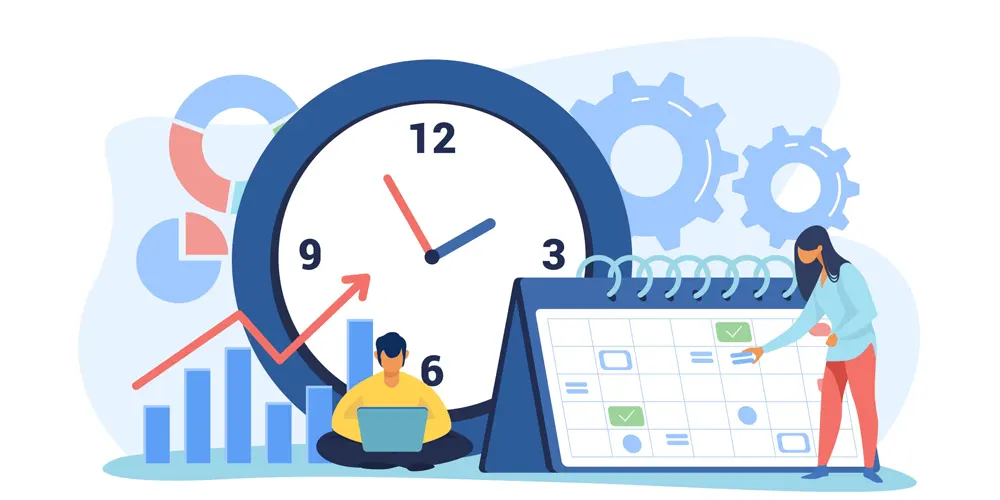Predictive Dialler vs Progressive Dialler - Understanding the Differences
Choosing the perfect dialler can become overwhelming considering how many options are available in the market. As VoIP carriers and customer service decision makers, knowing these diallers in detail is necessary to pick or suggest the best one.
It is especially tricky for businesses operating in medium to large-scale customer service operations. You might have to connect with a large number of people while also maintaining an amazing customer experience.
Considering these objectives, two dialler options that come on top are the predictive and progressive dialler. While similar, both are very different.
We shall dive into the details of the two diallers and compare them to help you decide on the best fit for your requirements.
Let’s get started then!
What are Predictive Diallers?

A predictive dialer is an automated telephony system used in call centres to make outbound calls. It uses advanced algorithms and historical data analysis to dial multiple phone numbers simultaneously and connect the calls to available agents.
The purpose of a predictive dialer is to maximise agent efficiency by minimising idle time and increasing the number of live conversations with customers.
When a predictive dialer is initiated, it analyses various factors such as the number of available agents, average call duration, and call abandonment rates. Based on this analysis, it calculates the optimal number of calls to dial at any given time.
The dialer then simultaneously dials multiple phone numbers, typically using multiple lines or channels. As the calls are being dialled, the predictive dialer monitors the progress of each call.
It distinguishes between answered calls, calls reaching voicemail, busy signals, or no response. When a call is answered, the predictive dialer quickly determines if it is a live person or an answering machine.
If a live person is detected, the call is routed to an available agent. The predictive dialer predicts the time it takes for an agent to finish a call and become available for the next call, adjusting the rate of outgoing calls accordingly to match agent availability.
With predictive dialers explained, we can now take a look at the key features it offers.
Key Features of a Predictive Dialler
1. Predictive Dialling: The primary feature of a predictive dialer is its ability to predict agent availability and call answer rates. By predicting agent availability, the dialer minimises idle time and maximises the time agents spend on live conversations.
2. Call Progress Analysis: A predictive dialer continuously monitors the progress of each dialled call. It can detect whether the call is answered by a live person, reaches voicemail, encounters a busy signal, or receives no response. This analysis enables the dialer to make informed decisions about call handling and routing.
3. Automated Call Routing: When a call is answered, the predictive dialer automatically routes it to an available agent. It ensures that the call is connected to the most suitable agent based on predetermined criteria.
The criteria include things such as skill set, language proficiency, or campaign assignment. This feature ensures efficient call distribution and enhances customer experience.
4. Intelligent Call Blending: Predictive dialers often include call blending capabilities, allowing agents to handle both inbound and outbound calls.
This feature optimises agent utilisation and ensures a seamless transition between inbound and outbound call handling.
5. Compliance and Do-Not-Call (DNC) Management: Predictive dialers incorporate compliance features to ensure adherence to regulatory requirements. They maintain and manage Do-Not-Call (DNC) lists.
The dialer automatically filters out numbers on the DNC list, helping organisations maintain compliance with telemarketing regulations.
With that, we’ve covered the basics of a Predictive Dialer. Let's move on and check out what a progressive dialer is.
What are Progressive Diallers

A progressive dialer is an automated telephony software system used in call centres and customer support operations for outbound calling. It automatically dials a list of phone numbers and connects the calls to available agents.
Unlike a predictive dialer that dials multiple numbers at once, a progressive dialer dials one number at a time, ensuring that there is an available agent to handle each call as it is dialled.
The progressive dialer begins by loading a list of phone numbers to be dialled. It continuously monitors agent availability and initiates the dialling process when an agent is ready.
Once the call is connected, the progressive dialer pairs it with an available agent. Thus ensuring that the agent who becomes available is connected to the dialled call.
It monitors the progress of each call to determine if it is answered by a live person, reaches voicemail, encounters a busy signal, or receives no response. Based on the call outcome, the progressive dialer offers different call-handling options to the agent.
For answered calls, the agent can engage in a conversation with the customer. For voicemail or busy signals, the agent can leave a pre-recorded message or schedule a callback.
After each call, the progressive dialer provides a brief wrap-up time for the agent to update call notes and prepare for the next call. It progresses through the call list, dialling one number at a time as agents become available, maintaining a smooth flow of calls.
Now that you know what a progressive dialler is and how it works, we can take a look at the key features it has to offer.
Key Features of a Progressive Dialler
1. Intelligent Call Progress Monitoring: A progressive dialer continuously monitors the progress of each dialled call in real time. It detects whether the call is answered by a live person, reaches voicemail, encounters a busy signal, etc.
This feature allows the dialer to make informed decisions about call handling and determine the best course of action for each call outcome.
2. Agent-Call Pairing: When a call is connected, the progressive dialer immediately associates it with an available agent. This ensures that the agent who is ready and waiting is connected to the dialled call.
It improves call efficiency and customer experience by connecting calls to the right agents without delay.
3. Dynamic Call Load Balancing: Progressive dialers employ intelligent algorithms to dynamically balance the workload across available agents. It considers factors such as agent availability, skill set, and call duration to distribute calls efficiently.
This feature optimises agent utilisation, prevents the overloading of individual agents, and ensures a fair distribution of calls within the team.
4. Adjustable Dialling Pace: A progressive dialer allows the dialling pace to be adjusted based on agent availability and campaign requirements. It ensures that calls are dialled at a rate that matches the available agent capacity.
This helps minimise wait times for agents and ensures a steady flow of calls. The dialling pace can be easily customised to optimise efficiency and maximise agent productivity.
5. Call Wrap-Up Time: After each call, the progressive dialer provides a designated wrap-up time for agents. This allows agents to update call notes, disposition the call, and perform necessary tasks before moving on to the next call.
The wrap-up time ensures that agents have sufficient time to complete post-call activities without feeling rushed or overwhelmed.
Now that you know all about the basics of a predictive and a progressive dialler, it's time to dive into the key differences between the two.
Key Differences - Predictive Dialler vs Progressive Dialler
We will explore the key differences between both the diallers in detail. This comparison will help you determine which dialler is more suitable for your requirements.
1. Dialling Approach
A predictive dialer dials multiple phone numbers simultaneously, typically using multiple lines or channels. It uses complex algorithms to predict agent availability and call answer rates.
This dialling approach aims to maximise agent efficiency by minimising idle time and ensuring agents are consistently engaged in live conversations.
A progressive dialer dials one phone number at a time and connects the call to an available agent. It waits for an agent to become available before initiating the next call.
This dialling approach ensures that an agent is always ready to handle each call as it is dialled, leading to a more controlled and personalised calling process.
2. Call Handling:
A predictive dialer relies on predictive algorithms to determine when to dial a number and how many numbers to dial. It automatically routes answered calls to available agents, skipping busy signals, voicemails, and unanswered calls.
The dialer aims to optimise agent productivity by connecting agents with live calls as efficiently as possible.
A progressive dialer connects each dialled call to an available agent in real time. It waits for an agent to become available before initiating the next call.
This ensures that agents handle calls more sequentially, giving them full control over call handling and allowing them to provide personalised service to each caller.
3. Call Connection:
A predictive dialer connects live calls to agents only when an actual person answers. It uses call progress analysis to detect live answers, avoiding connecting agents to voicemails, busy signals, or unanswered calls.
A progressive dialer connects every dialled call to an agent, regardless of whether it is answered by a live person, voicemail, busy signal, or no response. Agents have the responsibility of handling each call and deciding the appropriate action.
4. Agent Productivity:
A predictive dialer aims to maximise agent productivity by minimising the idle time between calls. It predicts agent availability and call answer rates, dialling multiple numbers simultaneously to keep agents engaged in live conversations and minimise downtime.
A progressive dialer ensures agents have more control over their workload and call handling. It dials calls one at a time, allowing agents to handle each call before moving on to the next.
While this may result in slightly more idle time between calls, it allows agents to provide personalised attention to each caller and have more flexibility in call handling.
5. Compliance and Call Quality:
Predictive dialers are more susceptible to dropped calls or abandoned calls due to the dialling speed and reliance on prediction algorithms. This can impact compliance with regulations and may result in lower call quality.
Progressive dialers have better control over call quality as each call is connected to an agent in real time. It allows for more accurate call routing and reduces the likelihood of dropped calls. Compliance with regulations can be more easily maintained as agents have more control over call handling.
6. Call Abandonment Rate:
Due to the simultaneous dialling of multiple numbers, predictive dialers may experience a higher call abandonment rate.
This occurs when there are more connected calls than available agents, leading to calls being dropped or abandoned before an agent can handle them.
While predictive dialers aim to minimise idle time, high call abandonment rates can impact customer satisfaction.
Progressive dialers typically have a lower call abandonment rate because calls are dialled one at a time, ensuring that an agent is available to handle each call.
This reduces the likelihood of calls being dropped or abandoned, resulting in a more favourable customer experience.
7. Flexibility in Call Handling:
Predictive dialers follow a more rigid and automated call-handling process. Calls are automatically routed to available agents based on predetermined criteria. Agents have less control over call prioritisation or refusal.
Progressive dialers offer greater flexibility in call handling. Agents can review customer information before making the call. This allows them to personalise the conversation and tailor their approach based on the customer's history or preferences.
Agents have more control over call prioritisation and can choose to skip or reschedule calls based on their judgement.
8. Scalability:
Predictive dialers are highly scalable and can handle large call volumes. They are designed to efficiently manage a high number of calls by utilising prediction algorithms and maximising agent utilisation.
Progressive dialers are also scalable, but they may require additional resources or agents as call volumes increase. As calls are dialled one at a time, the pace of dialling may be affected by the number of available agents.
However, modern progressive dialers often include features like intelligent call load balancing to optimise scalability and manage call volumes effectively.
With that, we’ve covered the entire comparison between the two diallers. In case you’re wondering which dialler is most suitable for a particular industry, let me show you.
Top 5 Industries Most Suitable for Predictive Diallers
1. Telemarketing and Sales:

The telemarketing and sales industry heavily relies on outbound calling to generate leads, conduct sales campaigns, and drive revenue.
Predictive dialers are well-suited for this industry as they automate the dialling process, optimise agent productivity, and ensure a higher volume of live connections.
The predictive algorithms help maximise the number of successful calls, increasing sales opportunities and conversion rates.
2. Debt Collection:

Predictive dialers are highly effective in the debt collection industry. They streamline the process of contacting debtors, improve agent efficiency, and increase the chances of successful debt recovery.
With features like call progress analysis and intelligent call routing, predictive dialers help debt collection agencies connect with debtors more efficiently, resulting in improved collection rates.
3. Market Research and Surveys:

Conducting market research and surveys often involves making a large number of outbound calls to gather data and feedback.
Predictive dialers automate the calling process, allowing market research firms to reach a broader target audience quickly.
The dialers maximise the productivity of survey agents by minimising idle time and connecting them to live respondents, enabling efficient data collection and analysis.
4. Appointment Scheduling and Reminders:

Industries such as healthcare, professional services, and field services rely on scheduling appointments and sending reminders to customers.
Predictive dialers excel in this area by automating the process of contacting customers for appointment scheduling, reducing no-shows, and improving overall efficiency.
The dialers can handle a high volume of calls, ensuring timely reminders and optimising appointment management.
5. Customer Service and Support:

While predictive dialers are commonly associated with outbound calling, they can also be used in inbound customer service and support operations.
By analysing call patterns and agent availability, predictive dialers can predict and manage incoming call volumes effectively.
They help distribute calls to available agents, minimise wait times, and ensure efficient call handling, resulting in enhanced customer satisfaction and reduced call abandonment rates.
Top 5 Industries Most Suitable for Progressive Diallers
1. Real Estate:

The real estate industry can benefit from progressive dialers for activities such as lead generation and property inquiries.
Agents can sequentially dial potential buyers or sellers, providing information and guidance throughout the property buying or selling process.
Progressive dialers help real estate professionals manage a high volume of calls while ensuring that each client receives individual attention and support.
2. Educational Institutions:

Educational institutions, such as universities or training centres, can leverage progressive dialers for student recruitment and enrollment.\
Admissions officers can reach out to prospective students in a sequential manner. They can address their questions, provide program information, and guide them through the application process.
Progressive dialers enable personalised communication, ensuring that each prospective student feels valued and supported in their educational journey.
3. Market Research and Surveys:

In industries focused on conducting market research, surveys, and opinion polls, progressive dialers offer significant advantages.
They allow researchers to connect with respondents sequentially, ensuring accurate data collection and survey completion.
Progressive dialers enable agents to provide a more personalised experience, resulting in higher response rates and improved data quality.
4. Appointment-Based Services:

Industries such as healthcare, professional services, and field services heavily rely on appointment scheduling and management.
Progressive dialers streamline the process of contacting customers for appointment confirmations, rescheduling, or sending reminders.
Agents can engage with customers on a one-to-one basis, ensuring efficient appointment management and reducing no-shows.
5. Inside Sales:

Progressive dialers are widely used in inside sales operations, where agents focus on nurturing leads, qualifying prospects, and closing deals.
The sequential dialling approach allows agents to give their undivided attention to each call. This way agents can build relationships with potential customers, and customise their sales approach based on individual needs.
Progressive dialers empower agents to maximise conversion rates by providing a personalised sales experience.
I hope that wasn’t too much information to consume! Let’s wrap things up now.
Conclusion
Long story short, both diallers are similar in terms of what they do. The difference boils down to how they handle calls and what customer experience they deliver.
If your objective is to connect with customers on a mass scale quickly, then a predictive dialler is a better option. However, this is suitable only when customer experience isn't of much importance.
If your objective is to connect with a lot of customers properly while delivering the best possible customer experience, then a progressive dialler is your best bet.
In case you want the best of both worlds, you can build your own dialler, as you want, with ConnexCS!























































































































